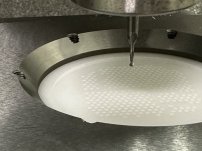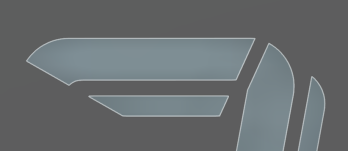KaminKevCrew
Plastic
- Joined
- Feb 19, 2023
I’m working on a design, and figuring out the best way to manufacture it has been making me think more and more about EDM machining.
Basically, the part in question has the overall nominal dimensions of 210mm x 68mm x 6mm. I need to put a bunch of holes (~150) that go through the 6mm dimension of the part, so the holes would be 6mm deep. Nearly all of the holes are very close to each other, and have a ~0.5mm wall thickness between them. The holes need to have as sharp of corners are possible, ~0.05mm radius would be ideal.
I have 3D printed some prototypes, and I have had another couple of prototypes laser cut from acrylic, as well as aluminum. The 3d prints aren’t consistent enough for what I need. The laser cut acrylic is pretty close, but the black acrylic I had cut is not opaque enough for this project, and bleed too much light. The laser cut aluminum had issues with the thin walls melting during the cutting process and is completely unusable.
I need all of these walls to be completely opaque to visible light, which is why I’m thinking that making this out of metal would be ideal.
Wire EDM - at least from what I can find online - doesn’t appear to work with wire that is as thin as I would need.
Sinker EDM seems like it might have the capabilities that I need. All of the walls of the part will be normal to the face of the part, so angles won’t be an issue. Ideally, I would like to have an electrode machined that can cut a large portion of this part (or all of it) in one operation, but I don’t know how feasible that is. Do sinker EDM machines have the capability to cut an entire part whose top surface is 210mm x 68mm, to a depth of 6mm? I have seen used sinker EDM machines up for sale for relatively low prices around me, but I don’t know that those machines would be capable of making all of these cuts without my having to line up each of the ~150 holes manually.
Additionally, if anyone knows of a better way of manufacturing this part (maybe water jet?) I’m all ears.
Basically, the part in question has the overall nominal dimensions of 210mm x 68mm x 6mm. I need to put a bunch of holes (~150) that go through the 6mm dimension of the part, so the holes would be 6mm deep. Nearly all of the holes are very close to each other, and have a ~0.5mm wall thickness between them. The holes need to have as sharp of corners are possible, ~0.05mm radius would be ideal.
I have 3D printed some prototypes, and I have had another couple of prototypes laser cut from acrylic, as well as aluminum. The 3d prints aren’t consistent enough for what I need. The laser cut acrylic is pretty close, but the black acrylic I had cut is not opaque enough for this project, and bleed too much light. The laser cut aluminum had issues with the thin walls melting during the cutting process and is completely unusable.
I need all of these walls to be completely opaque to visible light, which is why I’m thinking that making this out of metal would be ideal.
Wire EDM - at least from what I can find online - doesn’t appear to work with wire that is as thin as I would need.
Sinker EDM seems like it might have the capabilities that I need. All of the walls of the part will be normal to the face of the part, so angles won’t be an issue. Ideally, I would like to have an electrode machined that can cut a large portion of this part (or all of it) in one operation, but I don’t know how feasible that is. Do sinker EDM machines have the capability to cut an entire part whose top surface is 210mm x 68mm, to a depth of 6mm? I have seen used sinker EDM machines up for sale for relatively low prices around me, but I don’t know that those machines would be capable of making all of these cuts without my having to line up each of the ~150 holes manually.
Additionally, if anyone knows of a better way of manufacturing this part (maybe water jet?) I’m all ears.





 ratio...that might be a 0.8mm or 1/32" endmill which will be necked down for a stick out of 7.5 diameters.
ratio...that might be a 0.8mm or 1/32" endmill which will be necked down for a stick out of 7.5 diameters.